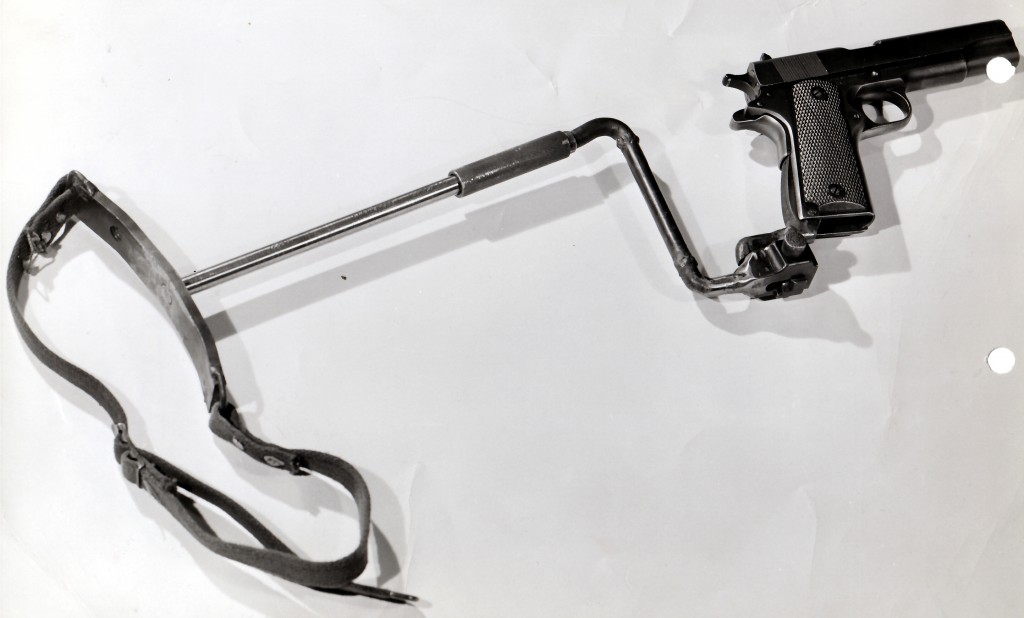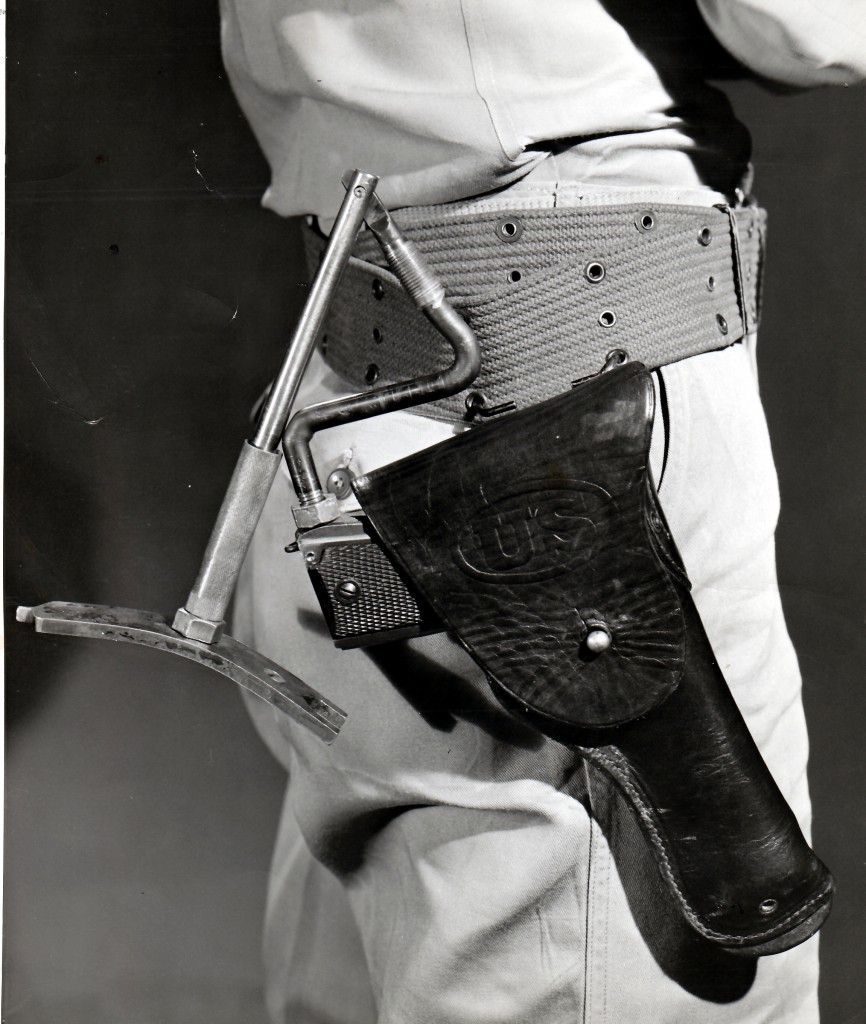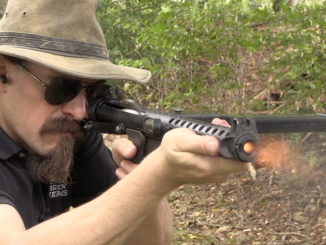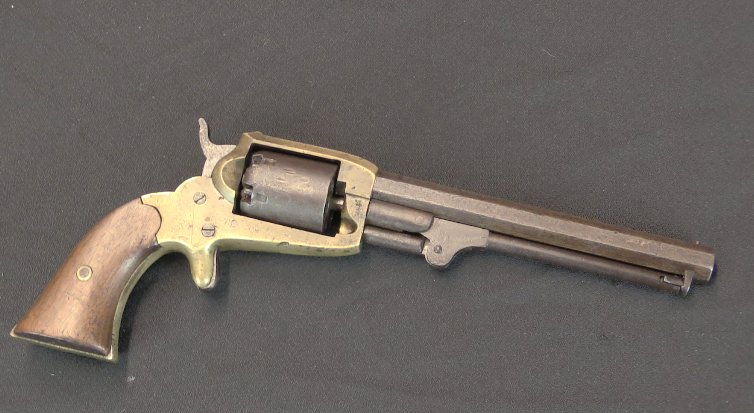From Tom Laemlein:

A few years back I found these photos of a Marine Corps modification of the standard M1911 .45 caliber pistol. Unfortunately there was no accompanying documentation. A unique folding extension stock—it would interesting to know if any of the “Forgotten Weapons” readers have any information about this rare modification. I would suspect it helped accuracy but not enough to justify the extra weight and the cumbersome nature of the added metal parts.

Tom Laemlein runs Armor Plate Press, a military history publishing company that specializes in producing photo studies of 20th Century weapons systems.




Cumbersome is always relative. Compared to a regular pistol, yes. But if your normal gun is a rifle, even a small carbine, this is much less cumbersome on guard duty if you have to keep checking papers etc.
“if you have to keep checking papers etc.”
If so regular 1911 will be totally enough. In Europe even this could as too much, for example in Germany during WW2 pistols chambered for .32 Auto (7,65mm Browning) were popular – see for example Walther PP.
is: “could as too”
should be: “could be considered as too”
The reason why most of Europe thought (thinks!) that small caliber hand guns are acceptable is because that except for England, none of them has had extencive experiance dealing with the “Native” populations in the colonies who were not awair of the “fact” that getting shot was cause for falling down and dieing! England and America on the other hand both have that sort of extencive experiance and thus bought .45, or larger caliber hand guns.
To a degree perhaps though if my (very limited) military training is any indication pistols really arent considered useful as weapons of war outside of some very specific circumstances.
According to friends in the military who were deployed to Afghanistan, Iraq and Mali they rarely ever brought them on patrols, preferring to bring an extra magazine or two for their carbines or a bottle of water and a sandwich.
Well, that was certainly that they thought .45 caliber handguns were better. Everyone stops the story there and doesn’t continue to end. Those .45 caliber handguns weren’t putting those crazed natives down any better than the .38 caliber guns were. They’re called sidearms for a reason! They aren’t your main weapon, even if you’re an officer with only a sidearm, your main weapon is your unit. When you’re having to use your sidearm you’re in the “oh shit” situation.
If you happened to miss physics lessons; Europeans (some Albert) assumed that the energy of a projectile depends on the mass of the projectile and the square of its acceleration. In order to reduce the clumsy pistols and thus the recoil, they reduced the caliber and increased the loading. The result is the same energy as the old .45 calibers, or even better.
Interesting but little too elaborate and perhaps clumsy. Many designers tried this and keep trying since. Question to ask: if pistol has some inherent deficiency, why not use rifle/ carbine instead?
But I understand the point to increase utility of pistol and M1911 specifically and this is praiseworthy.
Primitive but as Mu states…if you checking donats, athletic newspapers, resting in a coffe shop…etc.
Neat, though I certainly hope that is a proof-of-concept rather than an actual prototype as it looks as heavy as the Colt! Still, not a bad concept if made lightweight and quick-detachable. A side-folding stock set up so the gun could still be holstered adn fired with the stock folded, high-visibility sights and extended magazines would have made a neat package handier even than an M1 Carbine, perfect for armor and air crew, for example.
“air crew”
The US Air Force issued the M4 Survival Rifle – http://en.wikipedia.org/wiki/M4_Survival_Rifle – it was designed as forager rifle, but also can be used as a combat. M4 Survival Rifle is lighter than M1 Carbine as well shorter due to telescoping stock.
Looks like an earlier, metal version of a carbon-fiber folding stock for the Glock I’ve seen pictures of. Think it is used in Europe by airport cops, etc. with the Glock 18. The stock-for-pistols thing is an idea that always seems to not work as well as the designer hoped, although after they were switched from Class 3 to C&R I did run a couple of magazines through an Inglis Browning Hi-Power with the wooden stock/ holster and it was pretty accurate out to 50 yards or so. Having the slide coming back at your face takes a little getting used to, though.
Good point, Jim — similar results to using the detachable wooden holster / stock assembly with a Mauser C96.
I noticed that the two photos show what are obviously two different pistols. The stock attachments to the mainspring housings are different, with the one shown in the holster being cruder. IIRC, a similar arrangement (but much more neatly made) to the “screw-in” stock was used by Lee Jurras on his limited run of stocked and scoped .357 Auto-Mag pistols in the early 1970s.
The holstered pistol shows the major drawback to this setup. That being that the folded stock would make sitting in a vehicle difficult unless it were a Jeep, where the stock could “hang” alongside that infamous narrow seat.
Also, the stock does a perfect job of fouling the holster flap and preventing a proper grip on the pistol, making a fast draw nearly impossible.
Far from “not surviving troop tests”, my SWAG is that this widget didn’t even get that far.
cheers
eon
I find it interesting that you found the stock to be moderately effective out to 50 yards or so, when most of the worlds armys’ after more than two centuries of experiance, that most handguns are accurate to that range or a little more as is. I find that most handguns are good to about 200 meters or so, if they are better than average specimens and you know the trajectory. I also found the Mauser C-96 with the long range sight to be perfectly adequate to well over 300 meters at known ranges. It’s a pitty that the club will not let anyone shoot on the new 500 meter range any handgun, or caliber weapon combo that has to much curviture of trajectory to clear all the intermediary “No blue sky” barriers from the benches!
For usage on long range the faster and therefore flatter-trajectory 7.63mm Mauser cartridge is superior to slow .45 Auto cartridge.
Sorry – wasn’t clear. I was shooting at a 50-yard target and got groups that I would normally expect from an old, well-used Browning at 25 yards – 6-8 inches. We were shooting at recycled #10 can lids (basically head sized) with issue sights and I was able to stay on target. Without the stock I would have been “close, but no cigar” with about half the rounds. Probably with the stock I could have stayed consistently center-of-torso out to 75 or 100 yards, but just couldn’t shake the notion that the slide was going to smack me in the face so it became one of those “there, now I’ve done it” items after about 25 rounds.
It looks like the stock in the top photo would position one’s eye well above the sights. These appear to be two different stocks, or the same stock in two stages of development. In the lower picture the stock is secured by a simple nut to the pistol, as opposed to whatever is going on in the upper photo. The welds on the vertical piece are smoother on the lower photo than on the upper photo. The lower stock may have the stock positioned lower for a better view of the sights. It looks like it would have caused problems with a proper shooting grip, the vertical bit of steel being in the way of one’s forearm.
The upper photo looks like the idea was to use the sling to position it under the arm for normal carry, while the lower photo was designed to be holsteted. Guess is the top photo was the first prototype, and the second photo a more realistic second model.
Overall, seems like a poor substitute for a grease gun. Only explaination is that it was an attempt by someone to make better use of the left-over stock of 1911’s after WWII.
My father used a 1911 modified to take a Mauser stock in WWII. He was a naval officer, so he was not issued with a Garand or Carbine. He wanted some more accuracy, plus less recoil, so he got his hands on a Mauser, cut stock mount off, welded it onto his 1911, and he was done.
If the barrel is only 5 inches, it does not matter that much what one puts behind it.
A carbine conversion makes more sense.
Agreed, but having fired some handguns with shoulder stocks, I have to say, they’re more accurate than you’d expect, especially since the rear sight is so much closer to the eye. But I’d still rather have an M-1 carbine.
Also the better recoil manage can be reason to create this device. Note that Mauser C/96 has their full-auto variant and the APS (abbreviation: Automatic Pistol Stechkin) full-auto pistol was designed with detachable stock.
That’s a very relevant point. The recent upsurge in advanced buttstock conversion kits that turn a atandard semi-automatic pistol into an ultra-compact PDW / carbine is telling evidence of this, eg., the FAB Defense KPOS system, which is definitely one of the best and most practical of this genre.
i was just thinking about this type of mod the other day and how useless it is. i guess people think that the stock is what makes a rifle more accurate and not the longer barrel. Takes all kinds they say.
Looking again at the top picture, with the strap it might be designed to be dangling of your shoulder while on guard duty, with both hands free. With a bit of training you might be able to get the gun up faster than drawing a pistol from your standard flap-over holster or grabbing an “over the shoulder” carbine. Looks like the stock has a release button to detach from the gun too, for regular use.
In Guns of the World (Petersen, 1972) Konrad Schreier’s article on the evolution of the M1 carbine (pp.76-79) includes a photograph of a 1911 with a long slide, muzzle device (sound suppressor?), extended magazine, shoulder stock, and what looks suspiciously like the adjustable rear sight of a Colt Shooting Master revolver. The caption reads;
The .45 M1911A1 as modified by Colt into a carbine with stock, extended magazine and lengthened slide/barrel group. A European concept which did not find favor here. Photo courtesy the late Col. B.R. Lewis, USA, ret’d.
I’m wondering if this device might not be a USMC “analogue” of the Colt prototype. Just a guess.
cheers
eon
Ever heard of the Heckler and Koch VP-70? It’ll only fire in bursts if you have the stock attached. Otherwise, it’s just a pistol. Just another little note: The VP-70 was one of the first polymer handguns. I’ve used one, and, as Hank said, it’ll be quite a bit more accurate. HK usually makes some accurate weapons, but the VP-70… WOAH!
Hi, Brandon :
Thanks for bringing up the topic — it was very astute of you to do so. I seem to recall that the H & K VP70 was discussed in detail on this site quite a while back. If I am wrong about this ( which I am perfectly willing to concede, given the amount of water that has passed under the bridge, so to speak ), it may have also involved an article posted on The Firearm Blog ( http://www.thefirearmblog.com ), to which web site Ian frequently contributes.
This stock only makes sense if it is paired with a select fire version of the 1911.
Some of those were made between the Wars, but the problem seemed to be that the traditional one-handed hold occasionally ended with a self-inflicted head wound from the cumulative recoil.
Selective-fire pistols seemed to have been “the thing” in Spain between the wars. A lot of people know about the Mauser Model 712 “Schnellfeuer” variant of the M1930 “Broomhandle” version; fewer know it was create as a response to the Spanish Astra 900 series, specifically the selective-fire 903 which Astra sold a lot of in China. Beistigui Hermanos did similar business with their selective-fire “Royal” MM31 Broomhandle “clone”.
Meanwhile Star was making the Model MD, a version of their 1911 clone in 9x23mm Largo (Bergmann-Bayard Long) with a fire-selector switch on the right side of the slide; it simply locked the disconnector plunger. There was also a version in .45 ACP; firing it on full-auto must have required some dexterity, not to mention the wrist and forearm muscles of Herakles.
My vote for the oddest one, though, goes to the Gabilondo y Compania Plus Ultra. A fairly typical Eibar-type Browning 1903 knockoff in .32 ACP, it was selective-fire and had an extended length butt to house a 22-round single-stack magazine.
The French briefly got into this game with the Union pistol in .32 ACP. It wasn’t selective-fire, but they did make a 35-round magazine for it which looked rather like a large “horseshoe” and had a sort of “cradle” at its far end to nestle around the front of the pistol’s frame ahead of the trigger guard, apparently to keep it from being bent if used as a foregrip.
Overall, the FN P-35 with its double-column magazine seems to have been a more sensible solution. The Kuomintang Army seemed to think so, as they acquired a lot of the Inglis-made version. Without any “rock and roll” switch, at that.
See; Ezell, Handguns of the World, chapters 9 and 13.
cheers
eon
I confess that I am not much good at all with a handgun. The M1911 is about the only pistol I can shoot at an acceptable level. So the idea of putting a shoulder stock on there is appealing to me, but it seems kind of pointless if the pistol is only a standard semi-auto weapon. If it was a machine pistol that would make more sense to me–turning the combination into a more useful submachine gun.
I have fired the Glock 18 and it is quite a thrill blasting out 9mm rounds at such an outrageous rate of fire. But other than in a shoot-out in a phone booth (anybody remember those?), I don’t think I could hit much with it beyond 20 yards or so.
I think the most sensible pistol-shoulder stock combination seems to be the Mauser pistol with its wooden shoulder stock/holster set-up. But I have never fired one of those (or had to lug one around), so I can only comment on the concept only.
I found a picture of the Colt that eon was referencing in Donald Bady’s ‘Colt Automatic Pistols’. Maybe not very practical but very interesting.
The Star select fire .45 ACP variant had a mechanism in the grip housing to reduce the rate of fire. It may have been more controllable than we tend to think.
A little clumsy, but I’d take it over a boltgun in the trenches. Not sure if I’d take it over a regular 1911 though.